Tomohon is a town in North Sulawesi about 30 km south of Manado, the city and airport where birders are most likely to arrive. Given the condition of the roads and the higher elevation (700-1000 meters) compared to Manado, it takes about one hour to get here from Manado.
One of its rather dubious claims to fame is its market – only in July 2023, dog and cat meat trading was banned at the market, with traders at the market agreeing not to sell or slaughter dogs and cats.
Still, the hunt for what is euphemistically called “bushmeat” continues. I saw some people in the fields who had just caught some rats, and the local guide talked about his neighbors in his village even hunting pittas.
In an article, a local conservationist describes the bleak situation as follows: “Over-exploitation drives the decline of iconic species and their habitats due to hunting for the illegal wildlife trade. The northern part of Sulawesi is an illegal wildlife trade hub for the region, supplying wildlife to markets across Asia and beyond. Hunting for subsistence is common around forested areas and includes the collection of maleo eggs for food. There is also a thriving bushmeat market for many wildlife species.”
Three birds are the main targets for visiting birders here (a honeyeater, a kingfisher, and a pitta) – but some of the other species are very interesting as well.
The Sulawesi Myzomela is a near-endemic on Sulawesi, and a member of the honeyeater family – a family mostly found in Australia.

It is thus on the Wallacea side of the Wallace line, which Wikipedia defines as follows:


“The Wallace line is a faunal boundary line drawn by the British naturalist Alfred Russel Wallace that separates Asia and ‘Wallacea’, a transitional zone between Asia and Australia. To the west of the line are found organisms related to Asiatic species; to the east, a mixture of species of Asian and Australian origins is present.”


The explanation for this borderline is that even when the ocean water levels were much lower in the distant past, there was still a deep-water gap between the two sides of the Wallace line, allowing for species differentiation.

Why anyone would call the Sulawesi Myzomela “yellow-winged” (Myzomela chloroptera is the scientific name) is a mystery to me.

The Sulawesi Myzomela seems quite abundant at the Gardenia Country Inn, a somewhat upmarket bungalow hotel in Tomohon – fortunately, there is no need to stay there overnight as they also serve decent lunch, which (as meals in Indonesian restaurants tend to take quite a while compared to what I am used to from China) gives you time to look for this and some other species.

Two munias can also easily be seen in the gardens of the hotel – the Scaly-breasted Munia …

… which can also be found in Shanghai, even though the range map in the HBW does not seem to be aware of this fact …

… and the rather elegant-looking Chestnut Munia, about which eBird is strangely unenthusiastic (“a small, plump reddish brown finch”). Maybe the reviewer had some personal issues on the day of writing the entry.

A non-birder friend with Afghan roots had the following association: “Looks like a niqab! Some Muslim women look like this.”

Of course, Sooty-headed Bulbuls are also easily found in the hotel gardens.

One study on their vocalization states “We assume that vocalizations play important roles in the communication of the three species because we noted these or those sounds in almost all observations.” Hmm, vocalizations are relevant for communication, what an interesting idea.

As these birds are not stupid (at least the individuals evolution has not weeded out over time), their flight initiation distance (i.e., how close they let a human get to them before flying away) depends on the local hunting pressure (source). As hunting pressure on Sulawesi generally is fairly high, this sometimes makes it difficult to see birds properly, though it does not apply within the hotel gardens.

Admittedly, maybe the juveniles look a bit stupid.

While rails are difficult to see in most places, on Sulawesi (including the hotel gardens) the Barred Rail is common and easy to see.


Its scientific name Gallirallus torquatus (torquatus means collared) does not make too much sense for the Sulawesi subspecies – other subspecies have a red breastband which presumably gave the species its name.

These rails share the gardens with the Isabelline Bush-hen, which is a Sulawesi endemic.


The isabelline in its name (and also in its scientific name) apparently indicates the color (“isabelline-coloured, greyish-yellow”), though I would be hard-pressed to call the color of the bird greyish-yellow.

Another species one might encounter at the hotel gardens is the Sulawesi Hanging Parrot also known as Great Hanging Parrot (this is despite eBird calling it a small parrot – Wikipedia explains that “With a total length of approximately 15 cm, it is a small parrot, but the largest species of hanging parrot.”)

Presumably the “stigmatus” (branded) in the scientific name Loriculus stigmatus refers to the red throat patch.
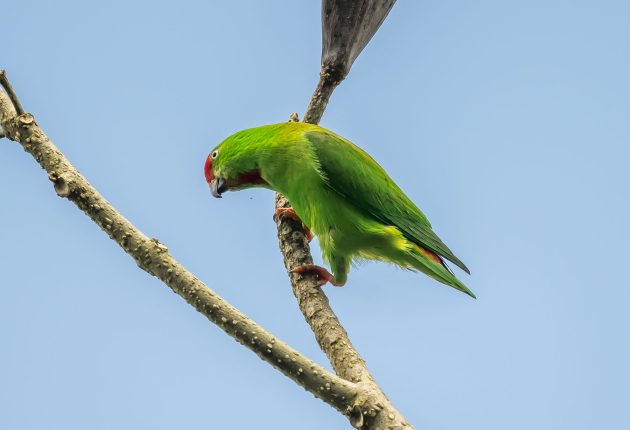
The male also has a red crown which the female lacks.
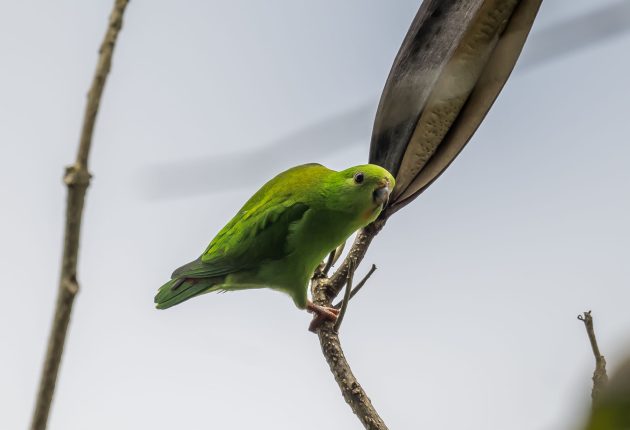
The hotel gardens also have at least three species of sunbirds – the Sahul Sunbird formerly known as Twitter …


… (not really, it was split from the Olive-backed Sunbird though) …

… the Crimson Sunbird …

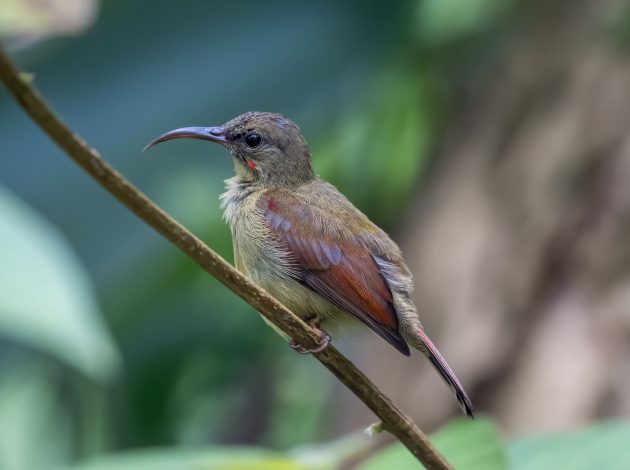

… and the Black Sunbird. I take it as an indication of my impressive masculinity that of the latter two species, only females came to have their photo taken by me.


At Gunung Mahawu, a mountain near Tomohon, more species can be found – several species of White-eyes including the Black-crowned White-eye …


… and the Pale-bellied White-eye.


The HBW lists 109 different species of Zosterops White-eyes, a bit of an overkill if you ask me. It shows in the similarity of names – apart from the Black-crowned White-eye, there is also a Black-capped White-eye (not shown). And that does not even include White-eyes outside of the Zosterops genus such as the Streak-headed White-eye, which I also saw here. Admittedly, it does not look like a typical White-eye.

While eBird describes the Sulawesi Blue Flycatcher as a “colorful blue-and-orange flycatcher”, this is less obvious in my rather bad photo. I am happy to blame this on the bad light on that day.

It seems to be a rather underresearched species – the HBW states “Many aspects of life history, including behavior and breeding, remain essentially undescribed.” Maybe this is also the reason for the somewhat puzzling scientific name Cyornis omissus (omissus means disregarded).

The Snowy-browed Flycatcher came out better and was the main entertainment while waiting for Sulawesi Pitta for a long time over two days.


A paper by a Malayan birdwatcher describes how the flycatcher used the birder as a feeding station, utilizing the attraction of the sweaty birder for small insects.


There is also the Citrine Canary-flycatcher.

Whoever gave the species its scientific name Culicicapa helianthea must have had a slightly poetic streak – helianthea combines the words for “sun” and for “blossom, flower”.
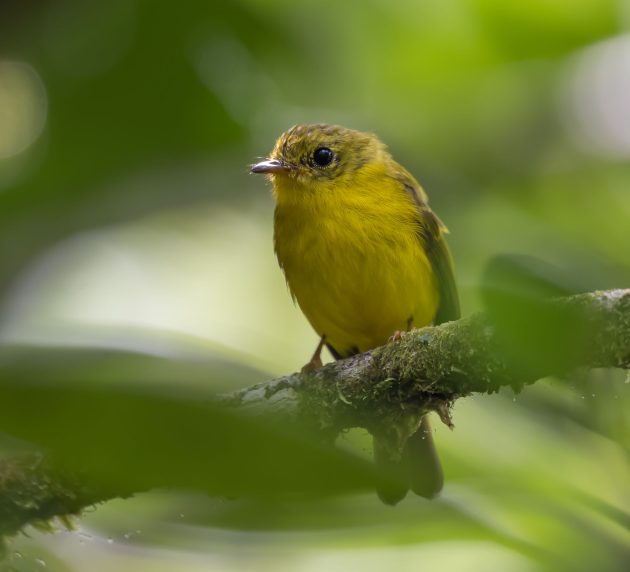
As for the Sulawesi Pitta, the first three attempts to see the bird (of a total duration of about 12 or 13 hours) all ended in complete failure for a bird photographer like me. A lister (which Grammarly tries to change to “A-lister” as it is apparently not familiar with birder-specific terms) might have found consolation in the fact that I heard the call of the bird each time – but that only meant I dreamt about the bird call, it did not give me the desired photo.
That left the Scaly-breasted Kingfisher as the third main target species – and fortunately, a very local bird guide found a pair. Not an easy task given that eBird states that the bird is found “in dense understory of forests in the hills and mountains” (which turned out to be very true).


The female has a buff-colored eyebrow and mustache.

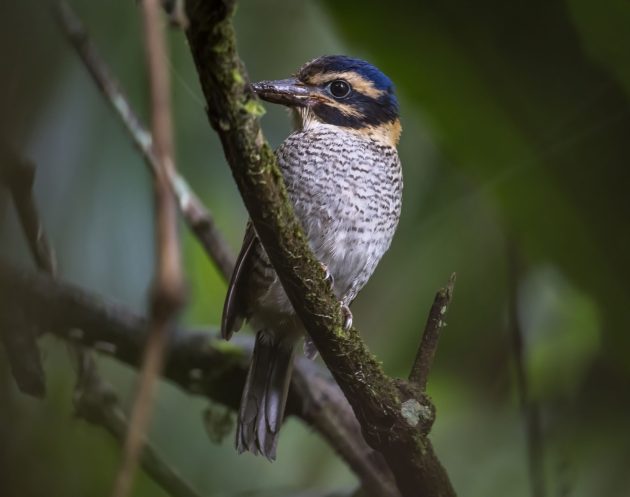
The scientific name Actenoides princess honors Charles Lucien Jules Laurent 2nd Prince of Canino and of Musignano and Prince Bonaparte (1803-1857), a French ornithologist, taxonomist, and collector.


While in the US in 1824, he tried to get the then-unknown John James Audubon accepted by the Academy of Natural Sciences, but this was opposed by the ornithologist George Ord who disliked Audubon’s dramatic bird poses and considered him to be “a back-country upstart who romanticized his subject matter” (from Wikipedia, the leading global source of trivial information).

Seeing a Crimson-crowned Flowerpecker was another compensation for missing out on the Sulawesi Pitta. And of course, the quest for the pitta was not over yet.

Source link

